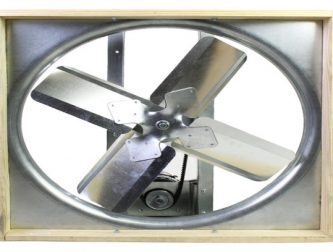In the world of commercial kitchens, the range hood is an unsung warrior. Amidst the sizzle and steam, choosing the right kitchen exhaust system can make all the difference. It is more than just aesthetics; it is about ensuring air quality, safety, and compliance with regulations.
In this blog, we take a closer look at the various factors to consider when looking at commercial kitchen exhaust hoods for your needs.
Ventilation goes beyond keeping the kitchen air fresh; it is about maintaining a healthy environment for chefs and patrons alike. Range hoods play a pivotal role in whisking away smoke, grease, and pungent odours, creating a conducive workspace. Moreover, compliance with health and safety regulations is non-negotiable, making proper ventilation a cornerstone of any commercial kitchen operation.
Kitchen exhaust hoods not only remove smoke and odours but also help to control humidity levels, preventing the buildup of moisture that can lead to mould and mildew growth. This is particularly crucial in commercial kitchens where high levels of humidity are generated from cooking activities. A commercial exhaust fan is not enough for the job. Additionally, range hoods also reduce fire hazards by removing grease particles and reducing the accumulation of combustible materials in the air.
These versatile hoods are a popular choice for kitchens with limited space or where the cooking area is against a wall. They are typically mounted above the cooking equipment and are designed to efficiently draw out airborne contaminants through ductwork.
Suited for kitchens with cooking stations positioned in the centre, island hoods hang from the ceiling directly above the cooking area. They offer unobstructed ventilation for island cooktops, ensuring effective smoke and odour removal without the constraints of wall placement.
For larger kitchens or those with multiple cooking islands, double island hoods provide enhanced ventilation coverage. They consist of two island hoods strategically positioned to cover expansive spaces, ensuring optimal air quality across the entire kitchen.
The dimensions and layout of your kitchen are crucial factors in determining the type and size of range hood required. Consider the available space, placement of cooking equipment, and overall kitchen design to select a hood that fits seamlessly into the environment. Consider factors such as ceiling height, countertop space, and the proximity of cooking equipment to walls or islands. Choose a range hood that provides adequate coverage of the cooking area and ensures proper ventilation throughout the kitchen space.
Assess the types of cooking equipment used in your kitchen and the frequency of culinary activity. Heavy-duty cooking appliances and high-volume cooking operations may require more powerful range hoods to remove smoke and grease effectively. Consider the heat output and ventilation requirements of different cooking appliances, such as grills, fryers, and ovens, when selecting a range hood. Choose a hood with sufficient airflow capacity and suction power to handle the demands of your kitchen’s cooking equipment.
The ventilation power and capacity of a range hood determine its ability to effectively remove smoke, grease, and odours from the kitchen air. These features efficiently capture and expel contaminants from the kitchen environment. Choose hoods with adequate CFM (cubic feet per minute) ratings to match the size and demands of your kitchen. Higher CFM ratings indicate greater airflow capacity and suction power, allowing the hood to capture and exhaust more contaminated air.
Balancing ventilation performance with noise considerations is essential to maintaining a comfortable working atmosphere. Look for commercial kitchen exhaust hoods equipped with noise-reducing features, such as sound-absorbing materials or variable speed settings, to minimise disruptive noise levels during operation. Choose a hood with adjustable fan speeds for quieter operation during periods of low cooking activity and increased ventilation power when needed.
Prioritise range hoods that comply with local health and safety regulations governing commercial kitchen ventilation. Ensure that the hoods meet standards for air quality, emission control, and fire safety to avoid potential fines or penalties for non-compliance. Choose range hoods that are certified by recognised testing agencies and comply with industry standards for performance, safety, and environmental protection.
Proper installation is paramount to the effectiveness and safety of range hoods. Ensure the hood is securely mounted and properly connected to ductwork to prevent air leaks and maximise ventilation efficiency. Hire our licensed and experienced technicians to ensure proper installation of commercial exhaust hoods on the Gold Coast.
Additionally, implement regular cleaning and maintenance practices to prolong the lifespan and efficiency of your ventilation system. This includes cleaning grease traps, replacing filters, and scheduling routine inspections to identify and address any issues promptly.
Maintaining proper ventilation in the kitchen is not a choice but a necessity. Selecting the right range hood for your commercial kitchen is a decision that requires careful consideration of various factors, as explained above.
Wired Air is your ventilation expert. From exhaust fan installation to restaurant fan repair services, our team is proficient in all types of tasks. For any help, contact us today.

If you have hired or are hiring electricians before, whether for a sma

Improving the air circulation in your house can ensure that every envi
| M | T | W | T | F | S | S |
|---|---|---|---|---|---|---|
| 1 | 2 | 3 | 4 | 5 | 6 | 7 |
| 8 | 9 | 10 | 11 | 12 | 13 | 14 |
| 15 | 16 | 17 | 18 | 19 | 20 | 21 |
| 22 | 23 | 24 | 25 | 26 | 27 | 28 |
| 29 | 30 | 31 | ||||

